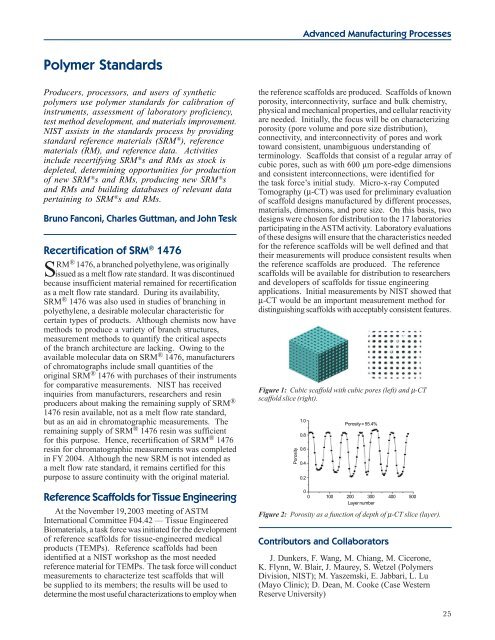Materials Science and Engineering Laboratory FY 2004 ... - NIST
Materials Science and Engineering Laboratory FY 2004 ... - NIST
Materials Science and Engineering Laboratory FY 2004 ... - NIST
Create successful ePaper yourself
Turn your PDF publications into a flip-book with our unique Google optimized e-Paper software.
Polymer St<strong>and</strong>ards<br />
Producers, processors, <strong>and</strong> users of synthetic<br />
polymers use polymer st<strong>and</strong>ards for calibration of<br />
instruments, assessment of laboratory proficiency,<br />
test method development, <strong>and</strong> materials improvement.<br />
<strong>NIST</strong> assists in the st<strong>and</strong>ards process by providing<br />
st<strong>and</strong>ard reference materials (SRM ® ), reference<br />
materials (RM), <strong>and</strong> reference data. Activities<br />
include recertifying SRM ® s <strong>and</strong> RMs as stock is<br />
depleted, determining opportunities for production<br />
of new SRM ® s <strong>and</strong> RMs, producing new SRM ® s<br />
<strong>and</strong> RMs <strong>and</strong> building databases of relevant data<br />
pertaining to SRM ® s <strong>and</strong> RMs.<br />
Bruno Fanconi, Charles Guttman, <strong>and</strong> John Tesk<br />
Recertification of SRM ® 1476<br />
S RM® 1476, a branched polyethylene, was originally<br />
issued as a melt flow rate st<strong>and</strong>ard. It was discontinued<br />
because insufficient material remained for recertification<br />
as a melt flow rate st<strong>and</strong>ard. During its availability,<br />
SRM ® 1476 was also used in studies of branching in<br />
polyethylene, a desirable molecular characteristic for<br />
certain types of products. Although chemists now have<br />
methods to produce a variety of branch structures,<br />
measurement methods to quantify the critical aspects<br />
of the branch architecture are lacking. Owing to the<br />
available molecular data on SRM ® 1476, manufacturers<br />
of chromatographs include small quantities of the<br />
original SRM ® 1476 with purchases of their instruments<br />
for comparative measurements. <strong>NIST</strong> has received<br />
inquiries from manufacturers, researchers <strong>and</strong> resin<br />
producers about making the remaining supply of SRM ®<br />
1476 resin available, not as a melt flow rate st<strong>and</strong>ard,<br />
but as an aid in chromatographic measurements. The<br />
remaining supply of SRM ® 1476 resin was sufficient<br />
for this purpose. Hence, recertification of SRM ® 1476<br />
resin for chromatographic measurements was completed<br />
in <strong>FY</strong> <strong>2004</strong>. Although the new SRM is not intended as<br />
a melt flow rate st<strong>and</strong>ard, it remains certified for this<br />
purpose to assure continuity with the original material.<br />
Reference Scaffolds for Tissue <strong>Engineering</strong><br />
At the November 19, 2003 meeting of ASTM<br />
International Committee F04.42 — Tissue Engineered<br />
Biomaterials, a task force was initiated for the development<br />
of reference scaffolds for tissue-engineered medical<br />
products (TEMPs). Reference scaffolds had been<br />
identified at a <strong>NIST</strong> workshop as the most needed<br />
reference material for TEMPs. The task force will conduct<br />
measurements to characterize test scaffolds that will<br />
be supplied to its members; the results will be used to<br />
determine the most useful characterizations to employ when<br />
Advanced Manufacturing Processes<br />
the reference scaffolds are produced. Scaffolds of known<br />
porosity, interconnectivity, surface <strong>and</strong> bulk chemistry,<br />
physical <strong>and</strong> mechanical properties, <strong>and</strong> cellular reactivity<br />
are needed. Initially, the focus will be on characterizing<br />
porosity (pore volume <strong>and</strong> pore size distribution),<br />
connectivity, <strong>and</strong> interconnectivity of pores <strong>and</strong> work<br />
toward consistent, unambiguous underst<strong>and</strong>ing of<br />
terminology. Scaffolds that consist of a regular array of<br />
cubic pores, such as with 600 µm pore-edge dimensions<br />
<strong>and</strong> consistent interconnections, were identified for<br />
the task force’s initial study. Micro-x-ray Computed<br />
Tomography (µ-CT) was used for preliminary evaluation<br />
of scaffold designs manufactured by different processes,<br />
materials, dimensions, <strong>and</strong> pore size. On this basis, two<br />
designs were chosen for distribution to the 17 laboratories<br />
participating in the ASTM activity. <strong>Laboratory</strong> evaluations<br />
of these designs will ensure that the characteristics needed<br />
for the reference scaffolds will be well defined <strong>and</strong> that<br />
their measurements will produce consistent results when<br />
the reference scaffolds are produced. The reference<br />
scaffolds will be available for distribution to researchers<br />
<strong>and</strong> developers of scaffolds for tissue engineering<br />
applications. Initial measurements by <strong>NIST</strong> showed that<br />
µ-CT would be an important measurement method for<br />
distinguishing scaffolds with acceptably consistent features.<br />
Figure 1: Cubic scaffold with cubic pores (left) <strong>and</strong> µ-CT<br />
scaffold slice (right).<br />
Figure 2: Porosity as a function of depth of µ-CT slice (layer).<br />
Contributors <strong>and</strong> Collaborators<br />
J. Dunkers, F. Wang, M. Chiang, M. Cicerone,<br />
K. Flynn, W. Blair, J. Maurey, S. Wetzel (Polymers<br />
Division, <strong>NIST</strong>); M. Yaszemski, E. Jabbari, L. Lu<br />
(Mayo Clinic); D. Dean, M. Cooke (Case Western<br />
Reserve University)<br />
25

















